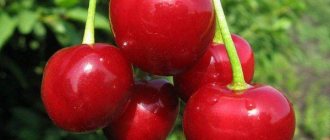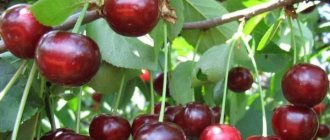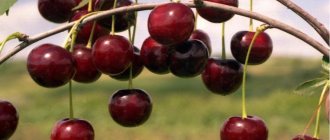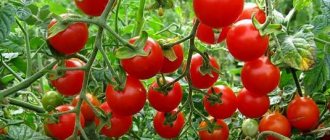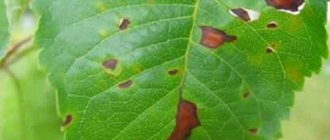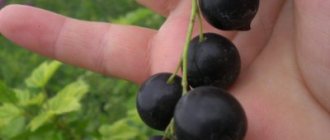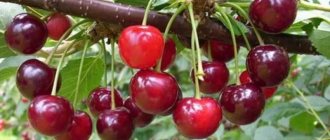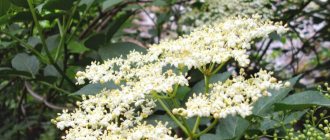Main characteristics of the variety
Thanks to many advantages, the variety can be considered one of the best varieties for cultivation in unstable climatic conditions.
Morel Bryanskaya is grown in the Central Black Earth region on an industrial basis.
Among the advantages are:
- Transportability. The fruits tolerate transportation well without losing their external or taste qualities.
- Winter hardiness. Morel easily withstands severe frosts and does not require warm winter shelter. The only warning is that young seedlings, especially if they are planted in the fall, should be wrapped in straw or special geotextile; if the roots do not have time to take root, the plants may die.
- Disease resistance. The variety is practically not affected by diseases that affect fruit crops. Even in unstable climatic conditions (in rainy or too dry summers), the tree calmly produces a bountiful harvest.
- Lack of pollinators. There is no need to grow several pollinator trees; cherries bear fruit well.
Self-fertility is an important quality of the cherry variety, which is especially appreciated by owners of small suburban plots. Another undeniable advantage of the variety is its unattractiveness to pests.
The tree is rarely affected by insects, which greatly simplifies care - preventive treatments against pests are carried out only once a year, preferably in the spring, even before the buds begin to bloom
Another undeniable advantage of the variety is its unattractiveness to pests. The tree is rarely affected by insects, which makes it much easier to care for - preventative treatments against pests are carried out only once a year, preferably in the spring, even before the buds begin to bloom.
Necessary agrotechnical measures
To successfully grow cherries and obtain a large harvest of high-quality berries, it is necessary to follow certain planting rules and carry out all agrotechnical measures efficiently at the time specified for them.
Correct fit
Cherries are always planted in early spring before the juices begin to flow and the buds awaken. Careful selection of a place for planting it, despite the good frost resistance of the variety, is important for the good development and growth of the plant. It is best to plant black cherries in a sunny and protected place from strong winds.
Important! Cherry prefers light soil, which must be pre-prepared: shallow digging and liming.
After about a week, any organic fertilizers are applied, about 15 kg per 1 square meter. m. After that, holes are prepared approximately 60 cm deep and 100 cm wide, and seedlings are planted according to a pattern of 2 ½ m by 2 m.
The planting hole is covered with soil from the top layer of soil mixed with a bucket of humus, 500 g of wood ash and 400 g of superphosphate. A peg is installed in the hole, to which the tree will subsequently be tied.
The seedling goes deep into the soil so that its root collar remains approximately 7 cm above the soil level. The filled hole is carefully compacted, and a hole of the required depth is made for watering the tree. After watering (about 15 liters per root), the soil is mulched. Dry compost, peat or sawdust is used for this purpose. With the correct selection of pollinators, a good harvest of quality products is ensured.
Important! This variety of cherry is self-sterile, that is, to pollinate it, you need to plant a couple of bushes of the same flowering period as it.
Plant care
Until the tree bears fruit, its main care comes down to periodic agrotechnical measures:
weeding;- watering;
- loosening the soil.
It is recommended to mulch the soil after watering to preserve moisture and prevent the formation of bark on the soil surface. Shallow loosening is carried out at least three times during the growing season. The need for fertilizing appears from the moment the tree begins to bear fruit.
Humus and compost are not added every year; the optimal time for their application is considered to be once every 2 years. Cherry plantings are fed with mineral fertilizers twice a year. During autumn digging, potassium and phosphorus fertilizers are applied, and in the spring it is necessary to apply nitrogen fertilizers. After 5 years, liming of the soil is applied. For this purpose, wood ash or dolomite flour is used.
Watering fruit-bearing trees is carried out during the ripening period of cherries, up to several buckets per tree.
Seedlings and young trees are watered more often, this is especially important in dry and very hot summers, in which case you have to water up to 3 times a month.
The first pruning of seedlings is carried out immediately after they are planted, leaving a few branches that will serve to form the crown of the tree. You need to leave the largest ones. In the spring, before the buds awaken, trees are pruned to lighten the crown. For this purpose, all branches growing inside the crown are removed. In addition, all branches longer than 40 cm are shortened and frozen or diseased ones are removed. Proper pruning reduces the risk of moniliosis.
Main diseases and pests of large-fruited cherries
A characteristic feature of the described variety is its tendency to fungal diseases such as moniliosis and coccomycosis, which affect the leaves of the tree and sometimes the berries.
The first signs of the appearance of coccomycosis are expressed in the formation of small brown dots on the outside of the leaf. Over time, they increase in size, and the lower part of the leaves becomes covered with a pink coating. Affected leaves quickly dry out and fall off. Diseased berries change shape and turn very black.
However, even with such symptoms, coccomycosis is not as dangerous for a tree as moniliosis, which affects all parts of the plant: leaves, branches, shoots and berries. In damp and cold weather, the disease develops very quickly, and growing brown spots on the leaves (similar to burns) are quickly replaced by damage to the trunk, shoots and the berries themselves.
Lack of timely treatment will destroy the tree, so at the first symptoms of the disease it is necessary to remove all infected parts, collect fallen leaves, cut off damaged parts of the bark from the trunk and burn them.
In the fight against moniliosis, spraying is used with a 3% solution of Bordeaux mixture, which is often used for preventive purposes, but at a concentration of 1%. In the war against coccomycosis, the most effective measure will be to spray trees with compounds based on copper oxide.
It is not difficult to find them on the modern market, but when choosing, it is better to give preference to systemic drugs that have a positive effect not only on the surface of the leaf, but also prevent the formation of spores inside it. Despite the fact that their cost is slightly higher, they will provide more benefits.
Do not be afraid to use chemical compounds at the first manifestations of these diseases, because affected berries are no less dangerous than modern fungicidal preparations.
Cherry “Black large” - characteristics
The tree of this crop is medium in size, reaches from three to four meters, the crown is trapezoidal, dense. The bark is grayish in color, dark, slightly rough, without cracks. The branches are tall, strong, slightly wide, grow straight, and have large internodes.
The color of the bark on young branches is green, but over time it changes to a dirty brown color, with a layer of grayish coating. The lentils are smooth, no hairiness is observed, light brown in color, sparsely arranged.
The buds are large, ovoid in shape, the crown is elongated, and grow at an angle from the branch.
The leaves are large, elongated, ovoid in shape, the crown is angular, rich green in color, shiny, there are small ribs along the edges, there are no stipules. The cuttings are strong, wide, tall, and smooth.
The buds are quite large; the inflorescence can consist of two or three flowers. The petals are large, snow-white, becoming darker towards the end of the inflorescence.
The fruits are quite large, weighing from five to seven grams, round in shape, slightly pressed down. The fruits do not fall. The peel is thin, almost black in color.
The contents inside are tender, juicy, wine-colored, the taste of the berry is sweet with a hint of sourness, it is often used in the design of cakes and pastries. The seed is medium in size and can be easily separated from the fruit.
The crop does not bear fruit independently, so it is necessary to plant additional pollinating varieties in the neighborhood, for example, the following: “Effective”, “Kentskaya”, “Turgenevka”, “Griot Ostgeimsky”, “Zhukovskaya”, “Rossoshanskaya Chernaya”.
Description of culture
As you can see in the photo of the Bessey cherry, it is a shrub 1–1.5 m high, up to 2.0 m wide. It grows in several trunks. Old branches are painted dark gray, young ones are red-brown. At first the shoots grow straight, then they droop, and by the age of seven they begin to spread along the ground.
The leaves of the Bessey cherry are somewhat similar to willow ones: the same elongated, lanceolate. Their length can reach 6 cm. The upper part of the leathery leaf blade is bright green, the lower part is grayish-silver. In autumn the bush turns red, which looks very beautiful.
Sometimes, even after the start of snowfalls, the cherry tree does not lose all its foliage.
At the end of spring, Bessey is literally covered with numerous flowers up to 1.5 cm in diameter, emitting a faint pleasant aroma. Sand cherry fruits are black, brown, and rarely greenish-yellow. Their shape varies from round to oval. The weight of the berries is up to 2 g, in selected specimens it is about 3 g. Delicate greenish, less often with reddish or burgundy veins, the pulp of Bessey is sweet, tart, sometimes astringent. There is sourness in the fruits, but it is barely noticeable. Sand cherry breeding is aimed at removing astringency.
How to plant on the site
Choosing the right place for planting seedlings and adhering to planting dates guarantees a harvest of tasty and juicy berries.
Cherry trees are planted in open ground depending on the climatic and weather conditions of the region.
In latitudes with a southern climate, planting work is carried out in the fall. In the northern regions, seedlings are planted in open ground in early spring. In areas with a temperate climate, tree planting can be done in both spring and autumn.
Preparing seedlings
When purchasing seedlings, a thorough inspection of the planting material is carried out. 1-2 year old plants with well-developed rhizomes take root best. The trunk of the seedling is smooth, without visible damage, with 2-3 skeletal branches. The root system is well moistened, without growths, compactions, fungal and putrefactive manifestations.
See also
Description and pollinators of felt cherry variety Natalie, planting and care
Read
Before planting in open ground, seedlings are placed in a container with warm, settled water for 4-8 hours. The roots of the tree are treated with special antibacterial drugs.
Important! If the seedlings have overdried rhizomes, they are left in water for 15-20 hours.
Selecting a location and preparing a planting hole
The development and growth of the tree depends on the place chosen for planting seedlings.
Well-lit areas that are not blown by winds or drafts are suitable for cherries. The permissible groundwater depth is at least 1.5-2 m.
If tree planting is planned for spring, soil preparation begins in autumn.
Peat, sand and humus are added to dense, heavy soil. Soil with high acidity levels is mixed with lime. The land is carefully dug up, organic fertilizers are added and left until spring.
Planting technology
The main work is carried out 2-3 weeks before planting seedlings in open ground.
- The soil is carefully loosened and holes are dug, 50-60 cm deep, 60-80 cm wide. The distance between plantings is chosen based on the size of adult trees, but not less than 2.5-3 meters.
- Place small pebbles or crushed stones at the bottom of the hole.
- The soil dug out of the hole is mixed with mineral fertilizers and ash.
- A support for the seedling is driven into the center of the hole and fertile soil is poured.
- The seedling is placed in the center of the hole, the rhizomes are carefully distributed and covered.
- Next, the soil is compacted and watered abundantly. The tree is fixed on a support.
Important! After planting is completed, the tree trunk circle of the seedling is mulched with sawdust or dry grass.
How to properly plant Besseya cherries
Bessey cherry: photo of the variety
The requirements of the Bessey sand cherry variety for the site and planting conditions are almost similar to the requirements of other cherry varieties. But there are still differences, and it is better not to lose sight of them.
When is the best time to plant cherries?
It is recommended to plant the Bessey cherry variety in the spring after the soil has warmed up. In areas with a warm summer season, containers with shrubs can be located on the plots throughout the entire period.
How to choose a site for planting.
The area should be well lit and protected from winds and waterlogging. It is forbidden to plant cherries in hollows or in areas that are swampy. The Bessey cherry variety can wither away and is sensitive to stagnant moisture in the root system. The optimal site for planting Bessey cherry is an elevated place.
The soil can be anything. Bessey cherry grows even on alkaline soils. It is better, of course, to plant cherries in soil rich in sand and organic matter.
When planting Bessey cherry, you should take into account the plants growing nearby. There is no need to plant cherries close to trees, raspberries, sea buckthorn, and black currants, as they will shade it. It is better to plant Besseya cherries close to other sand cherries.
How to select and prepare Bessey cherry seedlings
If you can grow material for planting Bessey cherries yourself, feel free to grow them. If this is not possible, then it is recommended to purchase planting material from specialized nurseries or time-tested garden stores. The roots should be well developed and the shoots should be red-brown in color. The branches must not have cracks or damage.
Progress of work.
- Initially, you need to make a soil mixture: mix the top layer of soil with humus, dolomite flour, ash and a handful of superphosphate.
- Next, we prepare a hole for planting Bessey cherry. Its size is 40x40x40 cm. If groundwater lies close to the surface layer of soil, then the depth is made greater, and drainage made of broken red brick, crushed stone, and sand is laid at the bottom of the pit.
- The interval between seedlings should be 2 meters.
- Then soil filled with nutrients is poured into the hole.
- A Bessey cherry seedling is placed in the center
- The root system is filled with the prepared soil mixture, and as the roots are buried, it is compacted so that empty spaces do not form.
- After planting around the circumference of the bush, it is necessary to form a soil roller and carry out good watering.
- Next, the tree trunk circle is mulched.
Features of wintering a tree
Peat is ideal for mulching trees
Despite the frost resistance of the variety, it is necessary to completely protect the tree from the cold. It is necessary to prepare young seedlings for winter frosts in the fall. To do this, the tree trunk circle is covered with a special mulch layer. Sawdust, rotted leaves or peat can be used as mulch. This coating will protect the tree's root system from freezing.
Additional Information! If you don't have mulch on hand, you can use soil instead. A layer of earth about 20-30 centimeters in height is poured near the trunk.
Chernaya Krupnaya is a common variety grown by many gardeners. People who want to plant such trees on their property must figure out in advance how to do it correctly.
general information
Duke is a hybrid form of fruit plant obtained as a result of an unplanned cross-pollination of the May Duck cherry with a cherry tree. This synthesis aroused the interest of breeders, so they purposefully began breeding seedlings of this species, using seedlings of the first cherry tree.
In the first half of the 19th century, people interested in growing cherry trees chose the Empress Eugenia and Queen Hortensia varieties for this purpose. In 1888, the Soviet biologist Ivan Vladimirovich Michurin, by crossing the Winkler white cherry and the Bel cherry, obtained the first domestic variety, which was called the Beauty of the North. Until now, it is considered the most frost-resistant duke. They even tried to grow the beauty of the North in Western Siberia, but not always successfully - often the flower buds of the trees froze, which led to low yields.
Until the end of the 80s of the 20th century, the choice of dukes was small. The different set of chromosomes in cherries (32) and sweet cherries (16) complicated the work of breeders. Most of the new varieties had flaws:
- Infertility - fruits were not set or there were very few of them.
- Frost intolerance - trees suffered from frost and were unable to survive the winter.
As a result, botanists working in scientific institutions of the Voronezh region still managed to obtain a group of fertile plants that were suitable for cultivation even in the northern regions.
History of selection and region of breeding
Chernaya Krupnaya was bred as a result of crossing such varieties as Black Cherry Shirpotreb and Zhukovskaya. The famous breeder A. Ya. Voronchikhin was involved in the creation of the new cherry.
Gardeners immediately liked the developed variety. Since 2000, it has been zoned in the North Caucasus. Black cherry is also often found in the Belgorod and Voronezh regions.
Currently, this variety is popular not only in the Russian Federation, but also in other countries. It can be found in Belarus and in the southern regions of Ukraine.
Appearance of cherry Black large
Let us consider separately the appearance of the fruit tree and its fruits.
Tree
The Black Large one is low, about 3-4 m, with a dense spreading pyramidal crown. The bark is gray, dark, slightly rough, not cracking. The shoots are long, of medium thickness, straight, with large internodes.
The bark on young shoots is greenish, with age it becomes grayish-brown, with a silvery coating. The lentils are not pubescent, reddish, and sparsely located.
The buds are quite large, oval, with a sharp tip, not adjacent to the shoots.
Leaves
The petiole is thick, long, not pubescent.
The flowers are quite large, growing 3, sometimes 2, in an inflorescence. The petals are wide, white, and darken towards the end of flowering.
Fruit
The berries of this variety are very large, weighing 5-7 grams, round, strongly flattened on the sides, and not prone to shedding. The skin is thin, very dark, almost black.
The pulp is tender and juicy, dark red, sweet with barely noticeable sourness, a very pleasant dessert taste. The stone is small and easily separated.
Advantages and disadvantages of the variety
Large black cherry is a fairly universal variety. Its fruits are perfect not only for fresh consumption, but also for further processing, including freezing. It can keep in the refrigerator for quite a long time – up to 1-2 months. Among the undoubted advantages of the variety are the following:
- good frost resistance;
- good yield;
- high precociousness;
- large-fruited.
Cherry fruits of the Large Black variety
The advantages of the Large Black variety include the low growth of the fruit tree. The not very large height of the cherry significantly simplifies for the gardener both the harvesting process and the implementation of the entire complex of agrotechnical measures to protect the tree from various diseases and pests.
This variety also has disadvantages. Of the most significant, two disadvantages can be named:
- fragility of the fruit tree;
- quite strong susceptibility to fungal diseases. This variety is most often affected by diseases such as moniliosis and coccomycosis.
Advice. When purchasing this cherry variety for your plot, you should take into account its instability to fungal diseases and always carry out appropriate treatments in the garden in a timely manner.
Cherry seedling care
Caring for the Large Black cherry variety has its own nuances. Due to its susceptibility to fungal diseases, the plant must be watered carefully, trying not to flood the root system. This hybrid is drought-resistant, so it is better to not sufficiently moisten the soil around it than to overdo it and destroy it. The seedling is watered for the first time after flowering, and at the same time fertilizing is applied. The second is when the fruits set and grow a little. During dry summers, additional watering will not harm the plant, so it can be increased to once every 2 weeks. One tree consumes 2-3 buckets of water. If the weather is rainy, the tree trunk circle must be carefully loosened to a depth of 15 cm, trying not to touch the roots. At least three such procedures are carried out per season. The soil around the cherry tree needs to be mulched regularly.
Cherry-cherry hybrids
Varieties obtained by crossing cherries and sweet cherries are usually called dukes. About 30 species of such hybrids grow in Russia. Several varieties will be described below.
Kharitonovskaya
Cherry with a medium ripening period. The height of the tree is 2.5 - 3 m. The branches form a spherical shape.
The cherries are dark red in color, juicy, weighing about 5 g. Sweet and sour. The stone can be easily separated from the pulp.
But she's quite big. They have good transportability. Fruiting occurs in the 4th year of planting.
It is capable of pollinating on its own, but for good fruiting the following varieties should be planted next to it:
- Vladimirskaya
- Lyubskaya
- Zhukovskaya
it is rarely affected by fungal diseases.
not suitable for cultivation in areas with severe frosts.
Podbelskaya
Tall tree - up to 5 m. The collection of branches forms a round shape.
Cherries are dark red in color, weighing up to 5 g. Fibrous. The taste is sweet and sour.
Fruiting begins 4–5 years after planting, in mid-summer. The fruits ripen gradually. The seed comes away from the pulp without difficulty. Can be used in any form.
This variety is not able to withstand strong drops in air temperature.
The plant's pollen is sterile. It is recommended to plant cherries next to it, or such varieties of cherries as:
- English early
- Lotovaya
- Anadolskaya
- May Duke
- Griot Ostheim
The combination of branches and leaves forms a pyramidal shape. The flowers are large and white. The fruits are dark red in color, weighing up to 10 g.
They taste sweet, similar to cherries. But the aroma is reminiscent of cherries. Full fruiting begins in the 4th year of planting. Productivity – 10 – 15 kg per tree.
The miracle bears fruit every year. The first harvest can be harvested at the end of June. This is a cross-pollinated cherry variety.
To get a harvest, you need to plant cherries next to it.
The branches of a tree have the property of stretching upward. To properly form the crown, some gardeners tie weights to the branches. The variety is better suited for warm regions of the country.
It is not worth planting in central Russia. The landing site must be chosen as windless, bright, and without close groundwater.
The plant must be pruned within 5 years. In the first year of life, during spring pruning, 1/6 of the shoots are cut off.
The variety is resistant to fungal diseases.
Cherry Miracle cannot become a pollinator - its pollen is sterile.
Baby
Plant height is 2 – 2.5 m. It grows very quickly. Not able to pollinate on its own.
Flowering begins in May. Early - bears fruit in June, 3 - 4 years after planting. 1 cherry weighs about 5 g. The color is dark red.
Up to 15 kg of crop is harvested from one plant. Pleasant to the taste, slightly sour. They are mainly used fresh, but they are also suitable for preparation.
Transportable. They are stored for no more than 10 days.
- high yield
- disease resistance
- endurance to strong drops in air temperature
- pleasant taste of fruits
Susceptible to certain diseases
The best neighbors for her:
- Youth
- Nord Star
- Lyubskaya
- Turgenevka
Shpanka
The variety was bred by Ukrainian breeders. Trees with early fruit ripening.
It is popular not only in its own country, but also abroad. These are tall plants up to 6 m. Fruiting begins at the age of 5–6 years, in June or early July.
The harvest is harvested gradually. An adult plant produces up to 0.5 centners of fruit. The cherry is dark brown in color, weighing 4–5 g.
Prone to shedding. There is a small bone inside that can be easily separated from the pulp. The taste is sweet, with a slight sourness. Can be used both fresh and for preparation and freezing.
Able to be pollinated by its own pollen. But at the same time, a small amount of fruit is obtained.
It is recommended to plant next to it:
- Griot of Ostheim;
- Ukrainian griot.
- ability to withstand low temperatures (up to -35 degrees);
- high resistance to diseases
- pleasant taste of cherries
- drought tolerance
- due to the tall growth of trees, it is difficult to pick fruits from them;
- The first harvest sometimes needs to wait up to 6 years.
For good growth, the plant must be planted in light, fertile soil.
Shpanka has many varieties:
- dwarf
- Bryansk
- large-fruited
- Donetsk
- early
Growing technique, planting and subsequent care
Before planting Black Large, you need to familiarize yourself with the main features of its cultivation.
Optimal soil types
Dark cherry, like most other fruit trees, prefers soils with a neutral acidity level. This is due to the fact that reduction-oxidation reactions can negatively affect the tree’s absorption of nutritional components. The ideal acidity level is 7 pH. However, minor deviations are allowed, both downward and upward.
If you have to plant a tree in acidified soil, you need to liming it in advance. To do this, you will have to add about 300-400 grams of lime for every square meter of land.
Reproduction methods
Using seeds is the easiest method of propagating cherries.
There are three ways to propagate cherries:
- Bones. This is the most common method, the effectiveness of which is 90%. In the summer, the seeds for further planting are collected, mixed with sand and transferred to a cool place until mid-October. Then they are planted in the garden in holes 6-8 centimeters deep.
- By cuttings. Cuttings that are cut off from the largest shoots are used as seed material. They are soaked in a growth stimulator for 12 hours and only after that they are planted in the ground.
- By layering. This reproduction technology is quite simple. At the beginning of spring, you need to find a shoot located at a distance of 20-25 centimeters from the trunk and chop it off with a shovel. Over the summer, the young growth should take root and already at the beginning of autumn it can be transplanted to a new place.
Important! Replanting the cuttings should be done before the onset of frost.
Pruning and crown formation
Garden shears - the best tool for pruning shoots
The first pruning should be done immediately after planting the cherry tree. About seven of the thickest shoots should be left on the plant for further crown formation. All subsequent times, branches should be removed in early spring, three weeks before the first buds appear.
Black Large does not tolerate crown thickening and therefore all shoots that are longer than 40 centimeters must be cut off. It is also necessary to get rid of all branches that grow into the crown. Each tree should have no more than ten main shoots.
Description of culture
The common name unites trees that are dissimilar in appearance of fruits and varietal characteristics.
Rossoshanskaya large
The description of the large Rossoshanskaya cherry variety should start with the fruits. Its berries are really large, reaching a mass of 6.7 g. Their shape is round - oval, slightly flattened on the sides, the color is very beautiful, rich dark burgundy.
Important! The berries are characterized by good transportability and are suitable for transportation over long distances. The crown of the large Rossoshanskaya tree has medium density, a pyramidal shape with vertically growing branches. This variety is excellent for growing in small garden plots, since the tree is compact and short in stature - no more than 4 m
During flowering, the large Rossoshanskaya cherry is very decorative due to its large snow-white flowers
This variety is excellent for growing in small garden plots, since the tree is compact and short in stature - no more than 4 m. During flowering, large Rossoshanskaya cherry is very decorative due to its large snow-white flowers
The crown of the large Rossoshanskaya tree has medium density, a pyramidal shape with vertically growing branches. This variety is excellent for growing in small garden plots, since the tree is compact and short in height - no more than 4 m. During flowering, the large Rossoshanskaya cherry is very decorative due to its large snow-white flowers.
The variety is intended for cultivation in the North Caucasus region.
Rossoshanskaya black
Not every variety can boast of such dark berries as black Rossoshanskaya cherries. They really are almost black with a barely noticeable burgundy tint. Large round berries have a very small seed and dense pulp. If they are fully ripe, it is easy to tear them off from the stalk - the tearing is dry, the stone also comes off easily.
Photo of black Rossoshanskaya cherry:
According to the description of the Rossoshanskaya black cherry variety, the low tree does not grow higher than 3 m. It is easy to care for and the berries are easy to pick. The neat crown has the shape of a pyramid. The foliage is strong, especially on young shoots.
Important! The pulp of the berries is quite dense, due to which they have good transportability. Reviews about the black Rossoshanskaya cherry say that it produces an excellent harvest in the North Caucasus, Central Black Earth and Lower Volga regions, where it is zoned. There it is grown not only in home gardens, but also industrially.
There it is grown not only in home gardens, but also industrially.
Reviews about the black Rossoshanskaya cherry say that it produces an excellent harvest in the North Caucasus, Central Black Earth and Lower Volga regions, where it is zoned. There it is grown not only in home gardens, but also industrially.
Rossoshanskaya gold
Let’s begin the description of the Rossoshanskaya Golden cherry variety with the fact that it fully justifies its name. The sunny, fleshy berries weigh up to 7 g. The description of the Golden cherry says that a tree illuminated by the sun all day produces berries with a pinkish tint. Photo of golden cherries.
The fruits are heart-shaped, slightly flattened on the sides. This variety is one of the ten most delicious and sought after. Reviews of the Golden Rossoshanskaya cherry are usually enthusiastic, and for good reason: a tasting score of 5 points is an excellent characteristic of the berries. The barely noticeable sourness and honey tint in the taste make it unlike berries of other varieties; this is always noted in the description of the Golden cherry variety. Among the cherries there are not many trees with yellow fruits, but even against their background it compares favorably, which is confirmed by the description of the Rossoshanskaya yellow cherry variety. The fruits are well transported, since the pulp has a dense structure and a dry separation from the stalk.
The description of the Rossoshanskaya Golden variety will be incomplete without mentioning the dimensions of the tree. For small gardens, it is very convenient that it has a low growth force - no more than 3 m. Like other varieties in this series, the crown is pyramidal, moderately leafy.
Photo of golden cherries:
Video about the Rossoshanskaya golden cherry:
Harvesting and storage conditions
You need to pick cherries near the stem.
Ripe dark cherry fruits must be picked three days before they are fully ripe. You can determine how ripe the crop is by the color of the peel. If it begins to darken quickly, then the berries can already be picked.
You need to pick the cherries carefully so as not to accidentally damage them. It is recommended to cut them close to the place where the stalk is attached. All healthy berries should be placed in a bowl or bucket. Damaged cherries are placed in a separate container.
Important! It is better to store the harvested crop in the refrigerator at a temperature of 1-3 degrees above zero.
Area of application of berries
Cherry is a universal berry that has a pleasant aroma and sourness. This allows you to use it in almost any recipe that contains fruits and berries.
Most often, housewives prepare jam, compote, jelly or jam from collected cherries. You can also make delicious tinctures from them.
Ferruginous cherry - middle zone sakura
Many people know about the Hanami holiday - the Japanese tradition of admiring cherry blossoms. Residents of the Land of the Rising Sun and numerous tourists go to parks and gardens in the spring with one goal - to see this wonderful beauty of lushly flowering trees.
Unfortunately, in central Russia and to the north there is no opportunity to enjoy cherry blossoms. It is possible to grow it up to the latitude of the Moscow region, but it will not bloom, since the flower buds freeze out in harsh winters.
Ferruginous cherry blossoms ferruginous cherry
Ferruginous cherry is an exclusively ornamental plant. Forms and varieties with densely double flowers have been developed, the abundance of which is simply amazing. You can get more detailed botanical information about this plant by reading the publication White foam of ferruginous cherry, where you will also see photos of white-flowered decorative forms of this plant.
Ferruginous cherry is not as tall as sakura: while Japanese beauties can reach 5 meters in height, “our” plant rarely grows more than 2 meters. Some hybrids set fruits that are decorative and edible, while others are sterile, and this often plays into the hands of ornamental gardening, since the space under the plant is kept clean.
Ferruginous cherry blossom
We invite you to see with your own eyes the wonderful blossoming of ferruginous cherry and fall in love with it once and for all. The video was prepared by Alexander Sidelnikov, a famous Russian experienced gardener. In it, he talks in a fascinating and detailed way about this plant.

